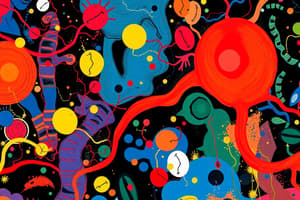Podcast
Questions and Answers
During glycolysis, glucose is converted into pyruvate. What is the primary purpose of this metabolic pathway?
During glycolysis, glucose is converted into pyruvate. What is the primary purpose of this metabolic pathway?
- To generate ATP and NADH for cellular energy. (correct)
- To break down proteins into amino acids.
- To produce fatty acids for membrane synthesis.
- To synthesize glycogen for energy storage.
In enzyme kinetics, what does a low Km value indicate about an enzyme's affinity for its substrate?
In enzyme kinetics, what does a low Km value indicate about an enzyme's affinity for its substrate?
- The enzyme's activity is highly dependent on temperature.
- The enzyme is easily saturated by the substrate.
- The enzyme has a low affinity for its substrate.
- The enzyme has a high affinity for its substrate. (correct)
Which of the following is a common mechanism of genetic regulation in bacteria, where a cluster of genes is transcribed together under the control of a single promoter?
Which of the following is a common mechanism of genetic regulation in bacteria, where a cluster of genes is transcribed together under the control of a single promoter?
- Operons (correct)
- Enhancers
- Promoters
- Silencers
In cell signaling, what is the role of a second messenger?
In cell signaling, what is the role of a second messenger?
Which level of protein structure is characterized by the overall three-dimensional arrangement of all the atoms in a single polypeptide chain?
Which level of protein structure is characterized by the overall three-dimensional arrangement of all the atoms in a single polypeptide chain?
During oxidative phosphorylation, what is the role of the electron transport chain?
During oxidative phosphorylation, what is the role of the electron transport chain?
How do non-competitive inhibitors affect enzyme activity?
How do non-competitive inhibitors affect enzyme activity?
What is the primary role of transcription factors in genetic regulation?
What is the primary role of transcription factors in genetic regulation?
In cell signaling, what is the function of receptor tyrosine kinases (RTKs)?
In cell signaling, what is the function of receptor tyrosine kinases (RTKs)?
What role do chaperone proteins play in protein folding?
What role do chaperone proteins play in protein folding?
Flashcards
Metabolism
Metabolism
Life-sustaining chemical transformations within cells, enabling growth, reproduction, and environmental response.
Catabolism
Catabolism
Breaks down molecules to release energy.
Anabolism
Anabolism
Synthesizes molecules, requiring energy input.
Glycolysis
Glycolysis
Signup and view all the flashcards
Enzyme Inhibitors
Enzyme Inhibitors
Signup and view all the flashcards
Competitive Inhibitors
Competitive Inhibitors
Signup and view all the flashcards
Transcription Factors
Transcription Factors
Signup and view all the flashcards
Operons
Operons
Signup and view all the flashcards
Epigenetics
Epigenetics
Signup and view all the flashcards
Cell Signaling
Cell Signaling
Signup and view all the flashcards
Study Notes
- Biochemistry explores the chemical processes within and related to living organisms
- It combines biology and chemistry to study the structures, functions, and interactions of biological molecules
Metabolism
- Metabolism involves life-sustaining chemical transformations within cells
- These processes facilitate organismal growth, reproduction, structural maintenance, and environmental response
- Catabolism and anabolism are the broad categories of metabolism
- Catabolism is the breakdown of molecules releasing energy
- Anabolism is the synthesis of molecules requiring energy
- Metabolic pathways are interconnected biochemical reactions
- Enzymes catalyze reactions ensuring specificity and efficiency
- ATP (adenosine triphosphate) is the main energy currency driving metabolic processes
- Glycolysis converts glucose into pyruvate
- The citric acid cycle (Krebs cycle) oxidizes acetyl-CoA, yielding energy carriers like NADH and FADH2
- Oxidative phosphorylation uses the electron transport chain to produce a proton gradient for ATP synthesis
- Photosynthesis converts light energy chemical energy in plants, and some other organisms
- Gluconeogenesis synthesizes glucose from non-carbohydrate precursors
- The pentose phosphate pathway produces NADPH and pentose sugars
- Fatty acid synthesis creates fatty acids using acetyl-CoA and NADPH
- Beta-oxidation breaks down fatty acids to produce acetyl-CoA, NADH, and FADH2
- The urea cycle converts toxic ammonia, a byproduct of amino acid metabolism, into urea for excretion
Enzyme Kinetics
- Enzyme kinetics studies the rates of enzyme-catalyzed reactions
- Enzymes are biological catalysts that accelerate reactions without being consumed
- Substrates are the molecules enzymes act upon
- The active site is where substrate binds and catalysis occurs on an enzyme
- The Michaelis-Menten equation relates initial reaction rate (v0), maximum reaction rate (Vmax), Michaelis constant (Km), and substrate concentration ([S]): v0 = (Vmax * [S]) / (Km + [S])
- Vmax is the maximum reaction rate when the enzyme is saturated with substrate
- Km is the substrate concentration at half Vmax, reflecting enzyme affinity for the substrate. Low Km indicates high affinity, and high Km indicates low affinity
- Enzyme inhibitors reduce or prevent enzyme activity
- Competitive inhibitors bind to the active site, preventing substrate binding
- Non-competitive inhibitors bind to a different site, altering enzyme shape and reducing activity
- Uncompetitive inhibitors bind only to the enzyme-substrate complex
- Allosteric enzymes have multiple binding sites and exhibit cooperativity
- Enzyme activity is affected by temperature, pH, cofactors, and coenzymes
- Cofactors are inorganic ions or organic molecules needed for enzyme activity
- Coenzymes are organic cofactors, often vitamin-derived
Genetic Regulation
- Genetic regulation controls gene expression: the transcription of genes into RNA and their translation into proteins
- Gene expression is regulated at levels like transcription, RNA processing, translation, and post-translational modification
- Transcription factors are proteins that bind to DNA and regulate transcription; activators enhance it, and repressors inhibit it
- Promoters are DNA sequences where RNA polymerase binds to start transcription
- Enhancers are DNA sequences that increase transcription from a distance
- Silencers are DNA sequences that repress transcription from a distance
- Operons are gene clusters transcribed together under a single promoter, commonly in bacteria
- The lac operon in E. coli controls genes for lactose metabolism
- In the absence of lactose, a repressor protein binds to the operator, preventing transcription.
- Lactose presence causes it to bind the repressor, detaching it from the operator and allowing transcription
- The trp operon in E. coli regulates genes for tryptophan synthesis
- Tryptophan abundance causes it to bind a repressor protein, which binds the operator, inhibiting transcription
- Epigenetics involves heritable gene expression changes without DNA sequence alteration
- DNA methylation, the addition of methyl groups to DNA, is often linked to transcriptional repression
- Histone modification involves changes to histone proteins, affecting chromatin structure and gene expression
- Non-coding RNAs like microRNAs (miRNAs) and long non-coding RNAs (lncRNAs) are key in gene regulation
Cell Signaling
- Cell signaling is communication between cells or between a cell and its environment
- Signals can be chemical (hormones, neurotransmitters, growth factors) or physical (light, mechanical stimuli)
- Reception is how a cell detects a signal
- Receptors are proteins that bind to signaling molecules and initiate responses
- A ligand is a molecule that binds to a receptor
- Signal transduction converts a signal into a cellular response
- Signaling pathways amplify and relay signals through molecular events
- Common pathways include G protein-coupled receptor (GPCR), receptor tyrosine kinase (RTK), and steroid hormone receptor pathways
- GPCRs are transmembrane receptors that activate G proteins upon ligand binding
- G proteins activate downstream effectors like enzymes or ion channels
- RTKs are transmembrane receptors that activate intracellular signaling pathways upon ligand binding and receptor dimerization
- Second messengers like cAMP, IP3, and calcium ions amplify and spread signals within the cell
- Cellular responses include changes in gene expression, metabolism, cell shape, or cell movement
- Termination of the signal prevents overstimulation and maintains proper cellular function
Protein Structure
- Proteins are biomolecules with polypeptide chains
- They perform various functions: catalysis, transport, structure, and signaling
- Amino acids are protein building blocks, linked by peptide bonds
- A polypeptide chain is a linear sequence of amino acids
- The primary structure is the amino acid sequence
- The secondary structure involves local folding like alpha-helices and beta-sheets
- Alpha-helices are coiled, stabilized by hydrogen bonds
- Beta-sheets are extended, formed by hydrogen bonds between strands
- The tertiary structure is the overall 3D shape set by side chain interactions like hydrophobic interactions, hydrogen bonds, ionic bonds, and disulfide bridges
- The quaternary structure is the arrangement of multiple polypeptide chains in a multi-subunit protein
- Protein folding is how a polypeptide chain gets its 3D structure
- Chaperone proteins aid folding, preventing aggregation and misfolding
- Protein misfolding can cause diseases like Alzheimer's and Parkinson's
- Domains are distinct structural and functional regions within a protein
- Protein purification techniques like chromatography and electrophoresis isolate and study proteins
- X-ray crystallography and NMR spectroscopy determine 3D protein structures
Studying That Suits You
Use AI to generate personalized quizzes and flashcards to suit your learning preferences.






